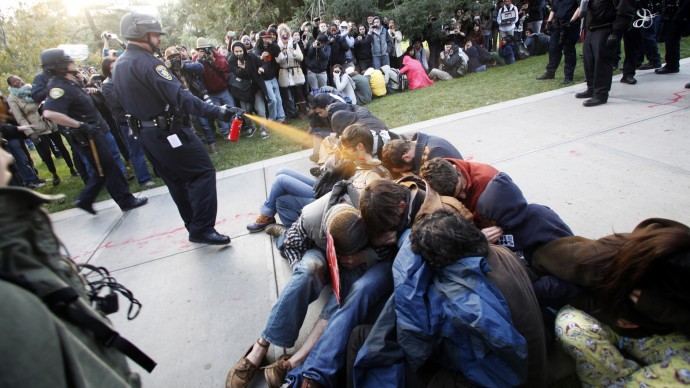
(MintPress) – Peaceful student protesters earned a slight victory for their cause when 21 plaintiffs stemming from a pepper spraying incident at the University of California-Davis last November were awarded around $30,000 each. During the incident, students demonstrated against rising tuition costs at the school by interlocking arms and occupying a portion of campus. When campus police arrived, some began casually pepper spraying the students, who posed no harm to the officers.
The event highlighted a resurgence of youth and students protesting for a cause they believe in, a rise that catapulted itself after the emergence of the Occupy movement.
While the figures of protesters in America are still modest to those seen during the Arab Spring, in Europe and in Montreal, young adults and students in the U.S. have felt the need to take to the streets when the deck has been stacked against them. Themes of income inequality, spiking tuition costs and student loan debt, unemployment and a lack of social mobility has created an atmosphere where young adults are pushing back.
The formation of the Occupy movement reintroduced America to demonstrations not seen since the countercultures of the 1960s and 1970s. And it was a rather youthful push, as well, with an estimated two-thirds of protesters falling under the age of 35. Over a quarter of the sampled demographics also classified themselves as active students seeking a high school or college degree.
Campuses act as catalyst
But the bulk of student protests in the U.S. have been at college campuses, where, like those at UC-Davis, rising college costs have put students in a pinch. A high-profile protest that occurred in May saw California State University students stage a fasting protest in which saw them forgo solid food. The students were speaking up against not only an increase in tuition, but a rise in class sizes and what they felt was a decline in the quality of education.
“The students have pledged to forgo solid food for at least a week, perhaps longer if the administration does not move to meet some of their demands, which include a five-year moratorium on student fee increases and a rollback of executive salaries to 1999 levels,” journalist Jennifer Medina told the New York Times.
Students in California also demonstrated a concrete plan, mimicking tactics seen by the Occupy push that used peaceful disobedience measures when traditional calls to action failed. Cal State Long Beach student Donnie Bessom said students always consider escalating measures when administrations overlook their efforts.
“We’ve tried pretty much everything, and they just ignore us,” Bessom told the Los Angeles Times. “We’ve talked to state legislators, written petitions, mobilized people on campus. The next step for us is in the tradition of nonviolent civil disobedience. They keep raising salaries and have those other luxuries, and we thought the symbolic nature of a hunger strike was appropriate to the crisis.”
The fruits of their labor have only recently been seen, as the instance at UC-Davis prompted legislation in California that required California State University system administrators to appoint liaisons to communicate with protesting students – a buffer that prevents campus police or administrators from acting aggressively toward peaceful demonstrations.
Joining a revolution
If it sounds as if California exemplifies student protest efforts around the country, that’s because it’s mostly true. Critics of the current generation of American students say they are far more passive than students in other countries and target petty things they tangibly deal with, and often deviate from policy and budget issues.
Earlier in the month, high school students at one Wisconsin school issued a boycott of school lunches after a program was implemented to cap the students’ caloric intake. Around 70 percent of the 830 students at Mukwonago High School boycotted the measure, which was implemented to tackle obesity issues and unhealthy student lunch options provided by the schools.
Zachary Bell, contributor to Campus Progress, said it is good for students to stand up for what they believe in, but noted that many of the causes taken up by American youth and young adults avoid the big picture and the most serious issues staring them down. Bell points to the British student demonstrations that exploited austerity measures in 2010 and, most notably, the recent protests over drastic increases to college tuition in Quebec.
For months, the streets of Montreal have been flooded with upward of hundreds of thousands of students, college faculty and citizens who denounce efforts by the province’s universities to hike up fees on students. Bell argues that protests like the ones in Montreal should be happening on American soil, as 53.6 percent of Americans under 26 with a bachelor’s degree are jobless or underemployed, translating into roughly 1.5 million people. He points out that those numbers “could fill a lot of streets.”
“American students need to create their own organizing culture, perhaps incorporating Quebecois syndicalism but without ignoring the principles of radical horizontalism employed by Occupy to address the uniquely American inequalities engraved into our identities — or else suffer terminal fractures like movements past,” Bell wrote for The Nation.
Liz Dwyer, education editor for the publication GOOD, said students in America are hesitant to disprove the workings of higher education institutes because the value of education and a degree is inundated in their minds as they grow up. She noted that the spread of tuition protests in California were a good sign that students were willing to stand up for their future and against skyrocketing student debt, which some say will rival the housing collapse when it hits its tipping point.
“Schools know they don’t have to listen because, ultimately, students want to get their degrees,” Dwyer wrote. “Once they’re enrolled in a school, most aren’t going to quit because of the increases – if they do they’ll owe thousands in loans. So students have been trained to suck it up and just keep borrowing. No wonder America’s total student loan debt now tops credit card debt.”


